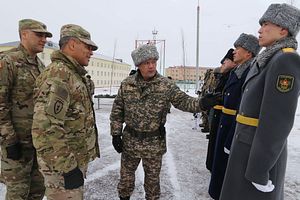It’s that time of year again: U.S. Central Command’s posture statement, our annual glimpse into the unclassified version of how CENTCOM is thinking about not only the largest of the combatant commands, but the one with two active war zones. For our purposes here at Crossroads Asia, the statement is one of the most public and concrete gauges as to what exactly American military minds are thinking about Central Asia.
First, an aside. To be blunt: the introduction to this year’s posture statement reads like someone based a fifth grade class presentation on CENTCOM on the speech patterns of President Donald Trump, except with better grammar, and a mix of military buzzwords and jargon, complete with “scare quotes” and bolding for important phrases. (The second paragraph begins like this: “The Central Region is a fascinating area of the world,” with that emphasis in the original).
Compared to the previous decade’s worth of CENTCOM posture statements, this year’s begins on a much more rudimentary note — I suspect this is a reflection of the author’s perception of the reader, in this case Congress, as well as reflective of a change in CENTCOM commander and commander-in-chief.
That said (and here’s a link to the last decade’s worth of posture statements if you want to do your own comparison on style and tone), diving deeper into the document for Central Asia reveals an interesting mix of same-old-strategy and nods to changing circumstances.
Elsewhere in the “CASA sub-region we have clearly demonstrated the ability to achieve good effects with modest investments in terms of building partner nations’ capabilities,” the statement notes before diving into a country-by-country assessment.
A few things jump out across the sections for the five Central Asian states. First, Afghanistan remains the overarching rationale for American security interest in these states, especially Tajikistan, Turkmenistan, and Uzbekistan (which I’ll get to separately later).
The Tajikistan section highlights the fact that Kunduz province, which the Taliban “intermittently fights for control of,” is “less than 160 miles from Dushanbe.” U.S.-Tajik military cooperation focuses on developing the Tajiks’ “capacity to address violent extremism, terrorism, and narco-trafficking; enhance border security; and, confront other trans-regional threats.”
Turkmenistan, according to CENTCOM, remains “concerned about the continuing instability in Afghanistan and, separately, the potential for the return of foreign fighters.” This is a bit different than how Ashgabat sees it, as I explained in a piece earlier today. In any case, language suggesting that Turkmenistan was interested in actually increasing military engagement with the United States, which first appeared in the 2015 statement, appears again, but with a caveat: “We are encouraged somewhat by Turkmenistan’s expressed interest in increased mil-to-mil engagement with the U.S. within the limits of their ‘positive neutrality’ policy.”
A second theme worth noting is that beyond Afghanistan the statement highlights the presence (and pressure implied) of Russia in the region.
The American military relationship with Tajikistan’s armed services, “is deepening despite Moscow’s enduring ties and the presence of the 201st Military Base near Tajikistan’s capital of Dushanbe, Russia’s largest military base outside of its borders.” Similar language is used with regard to Kyrgyzstan: “The Kyrgyz Republic sees political pressure from its larger, more powerful neighbors, including Russia, hosting a small Russian airbase outside the capital, Bishkek.” Uzbekistan’s new president, the section notes, “has reaffirmed the country’s unwillingness to allow other nations to establish military bases in Uzbekistan.” U.S.-Kazakhstan military engagement, “our most advanced military relationship in Central Asia,” is continuing to grow apace, “despite enduring Russian influence…”
It’s quite clear that the Russian presence is something on the American military mind.
A third theme is reserved for Uzbekistan: cautious optimism. Without insulting Karimov, CENTCOM’s posture statement welcomes the prospect of improved relations under new President Shavkat Mirziyoyev. The country’s first presidential transition in 25 years (unsaid is that it only happened because Karimov died late last summer), “is a promising development given Uzbekistan’s central and strategic geographic location, in the heart of Central Asia and bordering Afghanistan.” The Uzbekistan section notes, as mentioned above, that Mirziyoyev has reaffirmed the country’s no-foreign-bases policy and its dislike of regional military or political blocs, as well as “its self-imposed restriction against any type of expeditionary military operations.” Within those limits, the statement says, mil-to-mil efforts are focused on shared interests: border security, counternarcotics, counterterrorism, and preventing the return of foreign fighters.
In total, the CENTCOM posture on Central Asia remains very much in line with previous iterations of American military policy toward the region.

































